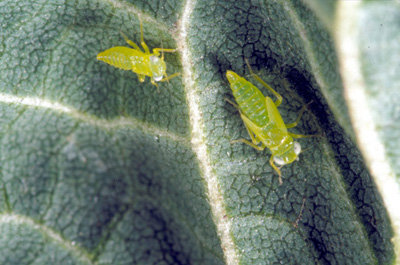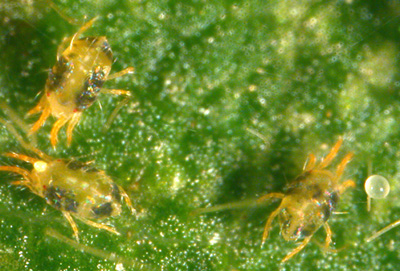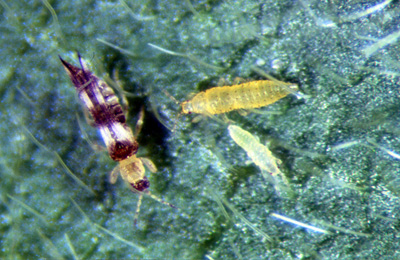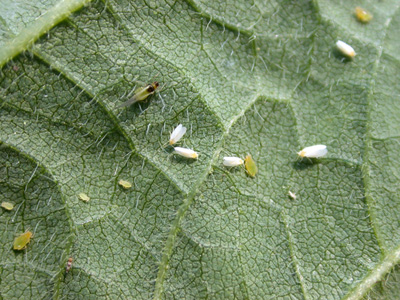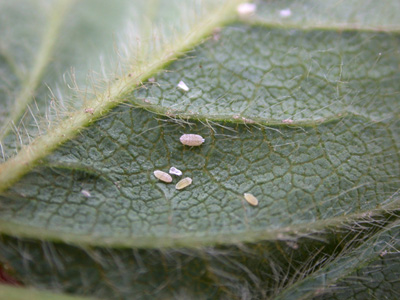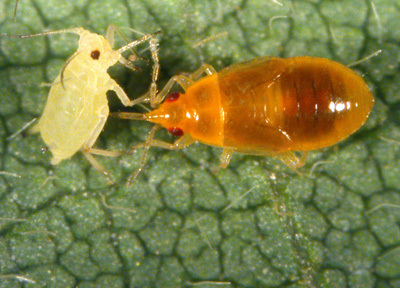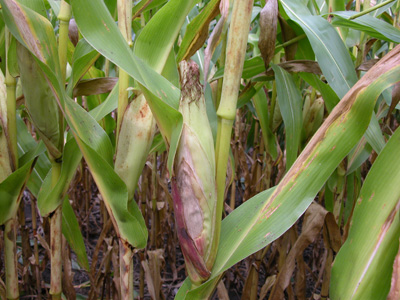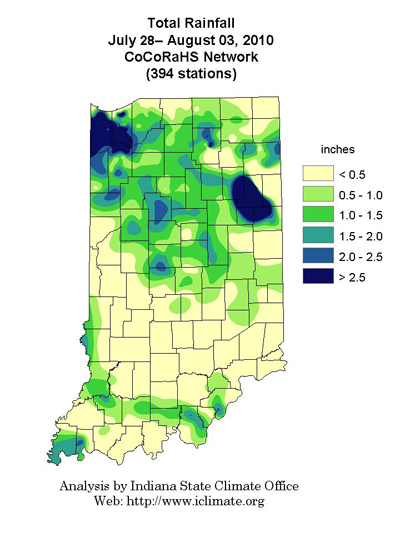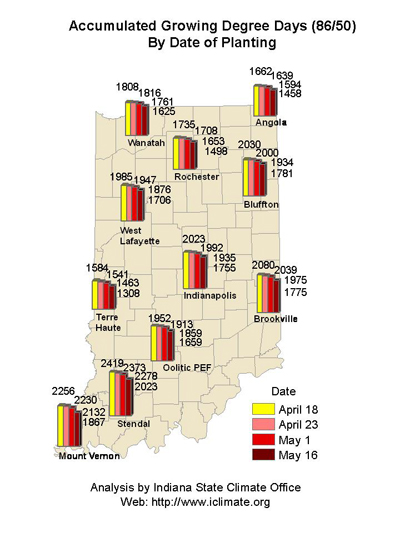Pest & Crop Newsletter, Entomology Extension, Purdue University
- VIDEO: Western Bean Cutworm Ear Damage
- Soybean Aphid Look-Alikes
- Black Light Trap Catch Report
- Western Corn Cutworm Adult Pheromone Trap Report
VIDEO: Western Bean Cutworm Ear Damage - (Christian Krupke and John Obermeyer)
We have had numerous reports of Western Bean Cutworm feeding throughout the state. The video below shows how to determine whether western bean cutworm larvae are feeding within the ear. Some damaged ears are obviously infested, whereas others show no outward sign. The treatment window for this pest is closed - insecticide will NOT reach the large larvae now under the cover of ear husks. Scouting now in suspect areas/fields, especially where moth flights were abundant (see table of moth counts from past weeks) will confirm western bean cutworm absence/presence and help pest managers make planting and scouting decisions for 2011. Remember that their distribution in a field is often spotty, so sampling multiple areas of the field is necessary.
Click to view this YouTube video
![]()
Soybean Aphid Look-Alikes - (Christian Krupke and John Obermeyer)
A call this week reminded us that soybean aphid are often confused with other small critters found on soybean this time of year. We are not aware of any fields in the state with economic levels of soybean aphid. For that matter, we have not heard of any fields with more than a few (10-20) aphids/plant. Many pest managers have been carefully observing backsides of leaves for this plant sucker. Some are surprised and unprepared to find the plethora of insects (most of which are not doing any damage whatsoever) occupying this zone, leading to frequent misidentification of soybean aphid. The following magnified images highlight some common critters often seen with or without soybean aphid. The use of at least a 10X magnifier is necessary to correctly see and identify these arthropods. Size and color are NOT reliable identifying characteristics; most of the following arthropods will readily move about the leaf surface but soybean aphid moves very slowly, and usually not at all. Look for the black cornicles, or “tailpipes” on a soft-bodied pale whitish green to green-yellow insect to confirm identifications.
Soybean Aphid
Soybean aphid colonized leaflet
Note the cornicles, "tailpipes" on the rear and antennae on the head of this feeding soybean aphid
Potato Leafhopper
Early nymphs of potato leafhopper and soybean aphid
Nymphs of potato leafhopper
Twospotted Spider Mite
Soybean aphid and spider mites
Microscopic picture of spider mites
Thrips
Soybean thrips adult and nymphs
Whiteflies
Upper canopy leaves with whiteflies
Close-up of adult whiteflies and soybean aphids
Mealybug
Mealybugs on new trifoliolate leaf
Close-up of mealybugs on leaf
Pirate Bug (Predator of Aphids)
Pirate bug adult feeding on a soybean aphid
Pirate bug nymph on a soybean aphid
![]()
Click here to view the Black Light Trap Catch Report
![]()
Click here to view the Western Bean Cutworm Adult Pheromone Trap Report
Harvest Aids In A Not So Cooperative Year – (Glenn Nice, Tom Jordan, and Bill Johnson)
Not many could boast that this year was an easy growing season. Some growers have dealt with a wet spring making it difficult to put in a crop, others with a wet summer making it difficult to apply postemergence herbicides. As a result, some of the weeds may have gotten away from us. If you are in this situation, no need to raise your hand, you might be thinking about using a harvest aid on that weedy field.
Harvest aids can help in the drying down process at harvest. In these cases the corn or soybean might be ready to harvest, but the pesky weeds are not. Harvesting into green weeds can make for a trying day with the combine. No body enjoys digging green morningglory vines out of the header as the sun sets and that forecasted rain is on the mind. The following herbicides are labeled to be used as harvest aids.
All harvest aid applications have to be applied after the crop has matured. This is after hard dough or when soybean has dried down.
Aim EC [2 lb ai/gal carfentrazone] – Aim can be used as a harvest aid at 1 to 2 fl oz/A in corn and small grains; and 1 to 1.5 fl oz/A in soybean, no earlier than 3 days before harvest. Keep in mind that if you have used Aim previously this year when considering using it as a harvest ai, it can’t total above 2 fl oz/A in corn or small grains and 1.5 fl oz/A for the season. Aim can aid in the dry down of velvetleaf, morningglory, piegweeds and others. Apply with a surfactant such as a non-ionic surfactant (NIS) at 0.255%v/v or a crop oil concentrate (COC) at 1 to 2% v/v. A nitrogen fertilizer such as UAN or AMS can also be added to the application. Use a minimum of 10 GPA with ground equipment and at lease 5 GPA with aerial applications to assure coverage.
Rage D-Tech [0.13 lb ai/gal carfentrazone + 3.93 lb ae/gal 2,4-D] – Rage D-Tech is Aim with 2,4-D to aid in the desiccation process. It can be used to help in drying down velvetleaf, morningglory, ragweeds, pigweeds and others in corn or small grains. Rage D-Tech does NOT have a soybean harvest aid label. Rage D-Tech can be applied at 16 to 32 fl oz/A, but like Aim, no less than 3 days and 7 days before harvesting field corn or small grains, respectively. If used previously that year the total maximum amount of Rage D-Tech is 32 fl oz/A in a year. Apply with NIS (0.25% v/v), COC or MSO (1 to 2% v/v). Do not let meat animals graze on treated plants for 14 days after application and do not feed treated straw.
Roundup Powermax [4.5 lb ae/gal glyphosate] – There are several glyphosate products that are labeled for use as harvest aids. This information is based on the Roundup Powermax label. If you are using a different glyphosate product please see your specific product’s label for rates and use restrictions. Apply up to 64 fl oz/A with ground equipment or up to 44 fl oz/A by air when the corn has reached maturity (black layer) at 35 percent grain moisture or less. Apply as a harvest aid to soybean up to 3.3 qt/A when soybean are mature, after pods have set and lost all green color. Do not harvest for feed or graze treated soybean for at least 45 days after application. Applications have to be made at least 7 days before harvest for both field corn and soybean. Use of glyphosate as a harvest aid is a good method to go after perennial weeds such as pokeweed and Canada thistle.
Gramoxone Inteon [2 lb ai/gal paraquat] – Gramoxone Inteon will provide fast dry down of weeds in corn and soybean. Apply at 1.2 to 2 pt/A to corn that has matured, after black layer, at least 7 days before harvest. Soybean harvest aid applications are different for varieties. Apply to indeterminate soybean varieties approximately when 65% of the seed pods have reached a mature brown color or when seed has a moisture of 30% or less. For determinate varieties, apply when at least a half of the soybean leaves have dropped and the rest of the leaves are turning yellow. For both corn and soybean add NIS at 0.25% and COC at 1% v/v. Do not harvest corn for at least 7 days after application. Do not harvest soybean for at least 14 days after application. Mature lambsquarter and cocklebur are tolerant to paraquat and may not dry down completely.
Diplodia Ear Rot Appears Early in Indiana - (Kiersten Wise and Charles Woloshuk)
Scouting reports across Indiana indicate that Diplodia ear rot is present in Indiana corn fields at low to moderate levels. Diplodia ear rot, caused by the fungus Stenocarpella maydis, was widespread and problematic in Indiana in 2009, and producers are concerned to see it in field this early in 2010.
Stenocarpella maydis infects plants through the husk or the shank, and can rot the ear before corn is fully mature. Infected ears often have bleached husks with tiny black specks on the outer layer. Removal of the husk of an infected ear will reveal white fuzzy growth of the pathogen between the kernels, which often starts at the base of the ear (Figure 1). The cob can also appear rotted.
The fungus infects corn at and during silking, and infection and disease development are favored by wet weather. April planted corn in Indiana experienced wet, humid weather at silking, which may have favored infection in susceptible hybrids. However, the weather conditions during the rest of 2010 will influence the final level and type of yield loss associated with Diplodia ear rot.
At this point in the season, there are no management strategies for reducing Diplodia ear rot levels in fields. Producers should scout fields prior to harvest and determine the level of incidence of the disease in the field. Fields with high levels of Diplodia should be harvested first, and stored below 15% moisture and cooled below 50°F to prevent further growth of the fungus.
Preventative management is the best way to reduce Diplodia ear rot levels in fields with a history of the disease. Avoid planting susceptible hybrids, and avoid corn after corn planting because the pathogen overwinters in the corn residue. For more information on Diplodia ear rot, please read the Purdue Extension bulletin, Diplodia ear rot at: <http://www.extension.purdue.edu/extmedia/BP/BP-75-W.pdf>.
Figure 1. Diplodia ear rot of corn
Excessive Heat and Humidity Not Ideal for Corn – (Tony J. Vyn)
It is commonly perceived that if summer weather is too hot and humid for people, then it must be ideal for corn because corn (in contrast to a crop like wheat) is a tropical crop. Up to a point, that perception is correct. Daytime temperatures up to 86°F are beneficial to corn plant photosynthesis and, when corn plants have adequate soil water and high humidity air, the leaf openings (stomates) are more likely to stay open and facilitate the exchange of carbon dioxide from the air for photosynthetic fixation by green chloroplasts in the cells of corn leaves. However, the rather continuous heat and high humidity conditions since the grain filling period started in Indiana (early July) have not been ideal for achieving high grain yields in 2010.
There are several negatives that are associated with excessive heat and humidity during the grain filling period:
- Leaf diseases are more likely to spread in high humidity situations. On susceptible hybrids, and in fields not sprayed with effective fungicides, the leaf area available for photosynthesis during the critical grain filling period can decline too rapidly. Corn plants are also more susceptible to stalk rot infection with high humidity and wet surface soils.
- At daytime temperatures above 86°F, the corn plant has lower net photosynthetic energy production and, therefore, fewer assimilates (e.g., sugars) available for corn kernel development.
- With warm nights (and particularly when night time temperatures exceed 70 or 80°F), corn plants expend more of the sugars they gain during the daylight hours on night-time maintenance respiration (sometimes referred to as “dark respiration”). Night-time temperatures of around 60-65°F during grain fill will result in higher grain yields than those we have been experiencing of late.
- High temperatures (whether day or night) during grain fill shorten the grain fill period between flowering and physiological maturity (i.e., black layer formation on the bottom of corn kernels). The primary driver of the rate of kernel filling is air temperature and, when air temperatures are high, sugars from current photosynthesis as well as remobilized sugars from leaf and stem reserves go to the ear sink even faster. Grain fill is a 24-hour, 7-day per week process, so both day and night time temperatures matter. Remobilization of sugars makes it more difficult to maintain healthy leaves for late-season photosynthesis, and it also lowers corn stalk strength. Lower overall temperatures during the grain filling period (such as we experienced in 2009) and longer grain filling periods (providing they are not cut short by frost) are the preferred conditions for achieving high yields when corn plants have a sufficient and healthy leaf area.
- Hazy and misty mornings during periods of high humidity mean a delay and reduction in sunlight energy received by the corn production factory. Less photosynthetic active radiation results in lower daily carbon dioxide fixation and, therefore, less sugar to help fill the corn kernels.
- Ear rots can be exacerbated by high humidity. Recent observations of diplodia ear rot, even when corn ears are only half way through their grain filling period, are a direct consequence of excessive and prolonged humidity around the junction of the leaf sheath and ear shanks. Problems with ear rot will limit corn yields most on susceptible hybrids already under stress (such as those fields with deficient nitrogen).
- High humidity also can reflect conditions of excessive rainfall, and excessive rainfall results in nitrogen (N) losses to both groundwater (via leaching of nitrate N) and to the air (via production of nitrous oxides). Excessive rain in many parts of Indiana in June already compromised N availability to corn plants, and heavy rains in July and early August have further limited the plant availability of mineral N (whether from residual fertilizer N or from mineralization of the soil organic N). Modern corn hybrids have much more “stay green” of their leaves than hybrids of previous decades, but the expectation of corn being able to take up 40% of their total-season N uptake during grain-fill is less likely this year than what we measured last year. That means that there will be more mobilization of leaf N and stalk N to the ear during grain fill than under more ideal weather conditions, and too much N mobilization will impair late-season photosynthesis rates.
- Prolonged wet soil conditions (especially in fields with inadequate drainage) have resulted in shallow root systems, and these fields are particularly sensitive to stalk lodging. The ear placement on corn plants are generally high because of the warm temperatures experienced earlier during vegetative growth, but the combination of thin stalks at high plant densities, higher stalk reserve remobilization to ears during this summer’s weather conditions, shallow roots after earlier floods, and high ear placement may cause more harvest losses in 2010 than in previous years.
- Each additional stress results in more than a simply additive effect from that stress alone. Pale green corn plants resulting from flooding or excessive rain in the pre-silk period are going to lose proportionately more yield from a high temperature stress than plants that were a healthy dark green at the beginning of the grain filling period. The same could be said for plants with considerable gray leaf spot or blight damage to their most important leaves (i.e. those around the ear itself). I am more concerned about the negative consequences of excessive heat and humidity this season than I would normally be because of the other stress factors corn has experienced in 2010. Overall corn hybrids are much more stress tolerant today than those of 30 years ago, but compounding stresses (especially during the grain fill period) can impose significant restrictions to final grain yield.
- High kernel set does not guarantee high yields. Warm and wet conditions (general absence of drought) through late vegetative growth in Indiana meant that we had high potential kernel numbers this season. We have had some kernel abortion occur in the first 2 weeks after pollination, and time will tell what the final kernel weights are going to be for the kernels that were retained. Final kernel size has considerable flex (20% plus variation in weight per kernel within hybrids at a particular plant density) so final yields are going to be affected by how much the current and future weather affects the supply of assimilates from the plant to the grain.
Summary
Corn fields are highly variable in 2010 (both within fields and from one field to another within and among production regions) and that greatly complicates yield forecasting. Excessive heat and humidity have taken their toll on the potential grain yield, but the extent of the loss is unknown at this point because of the host of interacting factors affecting actual kernel growth. Corn development is well ahead of normal, and these high temperatures will mean an early maturity and an early harvest. Had a drought occurred, grain yield reductions might have been more severe than those from excessive heat and humidity. However, just because we have avoided drought in 2010 does not guarantee above trend-line yields. Too much heat and too much humidity can be tough on corn as well as on Indiana residents. Let’s hope the remaining weeks during the grain filling period are cooler…….
Corn plant at R3 stage suffering from both low N status and diplodia ear rot
Premature ear death and aborted kernels from deficient N fertilizer and diplodia infection




